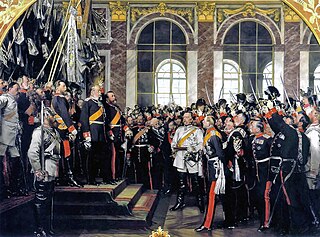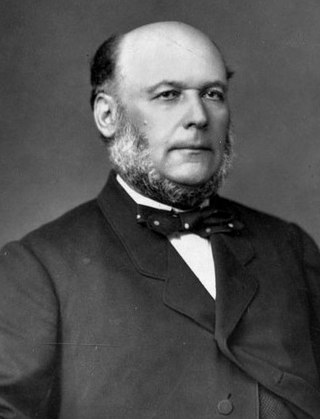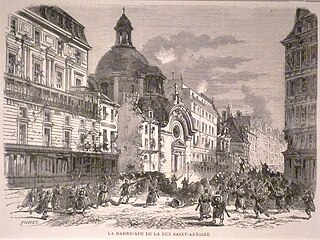
The Franco-Prussian War or Franco-German War, often referred to in France as the War of 1870, was a conflict between the Second French Empire and the North German Confederation led by the Kingdom of Prussia. Lasting from 19 July 1870 to 28 January 1871, the conflict was caused primarily by France's determination to reassert its dominant position in continental Europe, which appeared in question following the decisive Prussian victory over Austria in 1866. According to some historians, Prussian chancellor Otto von Bismarck deliberately provoked the French into declaring war on Prussia in order to induce four independent southern German states—Baden, Württemberg, Bavaria and Hesse-Darmstadt—to join the North German Confederation. Other historians contend that Bismarck exploited the circumstances as they unfolded. All agree that Bismarck recognized the potential for new German alliances, given the situation as a whole.

The Paris Commune was a French revolutionary government that seized power in Paris on 18 March 1871 and controlled parts of the city until 28 May 1871. During the Franco-Prussian War of 1870–71, the French National Guard had defended Paris, and working-class radicalism grew among its soldiers. Following the establishment of the French Third Republic in September 1870 and the complete defeat of the French Army by the Germans by March 1871, soldiers of the National Guard seized control of the city on 18 March. The Communards killed two French Army generals and refused to accept the authority of the Third Republic; instead, the radicals set about establishing their own independent government.

François Judith Paul Grévy, known as Jules Grévy, was a French lawyer and politician who served as President of France from 1879 to 1887. He was a leader of the Moderate Republicans, and given that his predecessors were monarchists who tried without success to restore the French monarchy, Grévy is considered the first real republican president of France. During Grévy's presidency from 1879 to 1887, according to David Bell, there was a disunity among his cabinets. Only one survived more than a year. Grévy paid attention chiefly to defense, internal order, and foreign relations. Critics argue that Grévy's confusing approach to appointments set a bad precedent for handling crises. Grévy's son-in-law was implicated in a corruption scandal in 1887, and Grévy had to resign after exhausting the pool of willing politicians to form a fresh government.

Marie Joseph Louis Adolphe Thiers was a French statesman and historian who served as President of France from 1871 to 1873. He was the second elected president and the first of the Third French Republic.

Marie Edme Patrice Maurice de MacMahon, marquis de MacMahon, duc de Magenta, was a French general and politician who served as President of France from 1873 to 1879. He was elevated to the dignity of Marshal of France by Napoleon III.

The siege of Paris took place from 19 September 1870 to 28 January 1871 and ended in the capture of the city by forces of the various states of the North German Confederation, led by the Kingdom of Prussia. The siege was the culmination of the Franco-Prussian War, which saw the Second French Empire attempt to reassert its dominance over continental Europe by declaring war on the North German Confederation. The Prussian-dominated North German Confederation had recently emerged victorious in the Austro-Prussian War of 1866, which led to the questioning of France's status as the dominant power of continental Europe. With a declaration of war by the French parliament on 16 July 1870, Imperial France soon faced a series of defeats at German hands over the following months, leading to the Battle of Sedan, which, on 2 September 1870, saw a decisive defeat of French forces and the capture of the French emperor, Napoleon III.

The Government of National Defense was the first government of the Third Republic of France from 4 September 1870 to 13 February 1871 during the Franco-Prussian War. It was formed after the proclamation of the Republic in Paris on 4 September, which in turn followed the surrender and capture of Emperor Napoleon III by the Prussians at the Battle of Sedan. The government, headed by General Louis Jules Trochu, was under Prussian siege in Paris. Breakouts were attempted twice, but met with disaster and rising dissatisfaction of the public. In late January the government, having further enraged the population of Paris by crushing a revolutionary uprising, surrendered to the Prussians. Two weeks later, it was replaced by the new government of Adolphe Thiers, which soon passed a variety of financial laws in an attempt to pay reparations and thus oblige the Prussians to leave France, leading to the outbreak of revolutions in French cities, and the ultimate creation of the Paris Commune.

The Treaty of Versailles of 1871 ended the Franco-Prussian War and was signed by Adolphe Thiers of the Third French Republic and Otto von Bismarck of the newly formed German Empire on 26 February 1871. A preliminary treaty, it was used to solidify the initial armistice of 28 January between the powers. It was ratified by the Treaty of Frankfurt on 10 May of the same year which confirmed the supremacy of the German Empire, replacing France as the dominant military power on the European continent.
Events from the year 1871 in France.

Henri Jules Bataille was a nineteenth-century French soldier. He rose to général de division of infantry, saw colonial service in Algeria, and fought in the Second Italian War of Independence and the Franco-Prussian War. He was awarded the Grand Cross of the Legion of Honour.

The Thiers wall was the last of the defensive walls of Paris. It was an enclosure constructed between 1841 and 1846 and was proposed by the French prime minister Adolphe Thiers but was actually implemented by his successor. The 33 kilometres (21 mi) long wall and ditch made a complete circuit around the city as it stood at the time of the July Monarchy. It was bombarded by the Prussian Army during the Franco-Prussian War, captured by government troops during the Paris Commune and refortified at the start of the First World War. However, by then it had become obsolete as a fortification and was a barrier to the expansion of the city. The area immediately outside of it, known as "the zone", had become a shanty town. The wall was demolished in the interwar period; its path today can be traced by the Boulevards of the Marshals which originally ran just behind the fortifications and by the Boulevard Périphérique which was later built just outside. A few remnants of the wall can still be seen.

Pierre Philippe Marie Aristide Denfert-Rochereau,, was a French serviceman and politician. He achieved fame by successfully defending besieged Belfort during the Franco-Prussian War: this earned him the soubriquet The Lion of Belfort.

The Armistice of Versailles that came into effect on 28 January 1871 brought to an end the active phase of the Franco-Prussian War. The signatories were Jules Favre, foreign minister in the provisional Government of National Defence, for the French and Otto von Bismarck, chancellor of the newly established German Empire, for Prussia and her allies. The suspension of hostilities initially lasted until 19 February, when it was extended through 26 February, when a preliminary peace treaty was signed, also at Versailles. The definitive Treaty of Frankfurt was signed on 10 May. Although technically an armistice, the military position of France at the time and the terms were such that it was de facto a conditional surrender by the vanquished to the victors.
The battle of Châtillon, also known as the battle of Châtillon-sous-Bagneux, was a skirmish in the siege of Paris between France and North German Confederation in the Franco-Prussian War, took place on 13 October 1870. This is also considered the first battle in the history of the French Third Republic. In this fierce battle – occurred at Châtillon and Sceaux, Corps V of the Prussian army under the command of Lieutenant General Infantry Hugo von Kirchbach, along with the II Corps of the Kingdom of Bavaria by the Supreme Minister infantry Jakob von Hartmann which were the forces of the army Group 3 of Prussia by Prince Friedrich Wilhelm as General command., won a victory against an attack by the XIV Corps under General Renault - of the French army under General Auguste-Alexandre Ducrot. Although some soldiers under Ducrot fought well, the majority of his army became agitated. The French were forced to flee to Paris, losing the Châtillon Plateau - a very favorable defensive position overlooking the fortresses south of Paris - to the Germans. This was a disaster for the "justice" of the French army during the war, although the French reported that they suffered only minor losses.

The proclamation of the German Empire, also known as the Deutsche Reichsgründung, took place in January 1871 after the joint victory of the German states in the Franco-Prussian War. As a result of the November Treaties of 1870, the southern German states of Baden, Hesse-Darmstadt, with their territories south of the Main line, Württemberg and Bavaria, joined the Prussian-dominated "North German Confederation" on 1 January 1871. On the same day, the new Constitution of the German Confederation came into force, thereby significantly extending the federal German lands to the newly created German Empire. The Day of the founding of the German Empire, January 18, became a day of celebration, marking when the Prussian King William I was proclaimed German Emperor at the Palace of Versailles, outside Paris, France.

Fort d'Issy was one of the fortifications of the city of Paris, France, built between 1841 and 1845. It was one of six forts built to the south of the main wall around the city. The fort was placed too close to the city to be effective, and had a poor design that did not take into account recent experience of siege warfare. It was quickly silenced during the Franco-Prussian War of 1870–71. After the armistice of February 1871 the fort was defended by National Guards of the Paris Commune against the French regular army in April–May 1871. The defense was irresolute and the fort was soon occupied. Today the site of the fort is an "eco-district", an ecologically friendly residential area.

The First cabinet of Jules Dufaure was the 54th cabinet of France and the second of the Third Republic, seating from 19 February 1871 to 18 May 1873, headed by Jules Dufaure as Vice-President of the Council of Ministers and Minister of Justice, under the presidency of Adolphe Thiers.

The semaine sanglante was a weeklong battle in Paris from 21 to 28 May 1871, during which the French Army recaptured the city from the Paris Commune. This was the final battle of the Paris Commune.
On October 31, 1870, a popular insurrection occupied Paris's City Hall. Amidst the Franco-Prussian War, Parisians simultaneously heard of losses at Le Bourget and Metz alongside armistice negotiations. Incensed by what they viewed as treason, a group of 300 to 400 demonstrated at the City Hall and members of the left-wing National Guard captured and occupied the building with several members of the Government of National Defense inside.

The Federated Legion of Women was an armed unit composed of women active during the Paris Commune in May 1871. It was founded in the 12th arrondissement, with the intended mission of hunting down deserters. The legion had uniforms, parades, and a standard-bearer, and was led by two officers, Colonel Adélaïde Valentin and Captain Louise Neckbecker. There were an estimated 20-100 members, most from working-class backgrounds. They held and attended meetings in Parisian political clubs, where they incited citizens to take up arms. After the defeat of the Commune, arrested members were given heavy sentences, including forced labour and deportation.



















